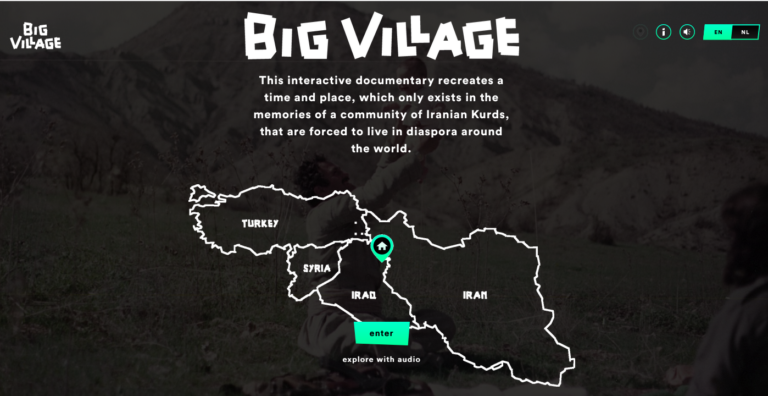
The Big Village interactive documentary website.
Big Village begins with a short historical overview of the Iranian revolution, when mass demonstrations and strikes toppled the Shah, Mohammad Reza Pahlavi, in early 1979. Due to the experience of social marginalization and political repression under the Shah, many Kurdish groups joined the revolution as well. The most prominent among them was the Democratic Party of Iranian Kurdistan (DPIK), which was founded in 1945 and developed into a serious political party with a social democratic program. After the 1953 coup d’état that overthrew Prime Minister Mohammad Mosaddegh—orchestrated by the American and British secret services—many members of DPIK were arrested and the party was repressed. By the late 1950s, most of its leaders had escaped to Iraq where they joined the Iraqi Kurdistan Democratic Party (KDP). But when the KDP started receiving aid from the Shah, with the goal of undermining Iraqi President Saddam Hussein, relations between DPIK members and the KDP deteriorated.
In 1967 a revived DPIK launched a rebellion against the Shah, which was defeated in 18 months. Mela Aware, one of the leaders of the rebellion and Shalmashi’s uncle, was among those who were killed. In 1973 the party elected Abdul Rahman Qasemlu as its leader and committed itself to armed struggle against the Shah with the slogan “Democracy for Iran, Autonomy for Kurdistan.” During the Iranian revolution, DPIK’s collaboration with Iranian communist organizations reached a zenith: Kurdish activists, supported by these organizations, established Associations for the Defense of Freedom and Revolution in most Kurdish cities. When these city councils demanded self-governance within a federal framework in March 1979, however, tensions increased between DPIK and the central state, which was now controlled by supporters of Ayatollah Khomeini and other Islamic forces. Kurdish Peshmerga (fighters) took control of army barracks and police stations in Sanandaj in mid-March and the rebellion spread to other Kurdish towns as the population tried to keep out the army. As the introduction of Big Village explains, the Kurdish rebellion was beaten back within a year and the Peshmerga retreated into the mountains.
Gewredê
After this defeat, DPIK crossed the border and set up camps in Iraqi Kurdistan, where they received support from Saddam Hussein, who invaded Iran in September 1980. Gewredê was built by KDPI on the ruins of an older village near the Iranian border and became a party headquarters where thousands of members and sympathizers lived, meetings were held, the Peshmerga were trained, a newspaper was published and radio programs were produced.
Beri Shalmashi was born in the “big village” in 1983, but two years later her family fled to the Netherlands. Others who fled the constant bombing of Gewredê by the Iranian state ended up in Australia, Iraq, France, Sweden and Switzerland. In 2018, Shalmashi travelled to interview those who had once lived in Gewredê. Her aim was not only to create a collective memory of Gewredê, but also to pay tribute to the life and struggle of its former inhabitants.
The documentary presents the struggle for Kurdish autonomy through interviews with former residents who published a newspaper and produced a radio program and through the memories of her own father who is still active in the party. But it also brings to life memories of everyday life through the eyes of a friend, pictures of children playing and adults dancing. These stories are a reminder of the simple pleasures of life in Gewredê, when Shalmashi would play in the snow in the winter and in the fields of flowers in the spring, when Peshmerga fell in love and married. But these pleasures were always overshadowed by the fear of bombs falling from the sky, the bombs that finally forced Shalmashi’s family to leave Gewredê in 1986.
[Peyman Jafari is a postdoctoral research associate at Princeton University’s Bijan and Sharmin Mossavar-Rahmani Center for Iran and Persian Gulf Studies.]
